Effects of Spectral Quality and Light Quantity of LEDs on In Vitro Shoot Development and Proliferation of Ananas comosus L. Merr
Abstract
1. Introduction
2. Materials and Methods
2.1. Plant Material and Culture Initiation
2.2. Light Treatments
2.3. Data Collection
2.4. Statistical Analysis
3. Results
3.1. Secondary Shoot Number
3.2. Secondary Shoots Dry Weight
3.3. Projected Canopy Index (PCI)
3.4. Chlorophyll Concentration
4. Discussion
5. Conclusions
Author Contributions
Funding
Data Availability Statement
Conflicts of Interest
References
- Morrow, R.C. LED Lighting in Horticulture. Hortscience 2008, 43, 1947–1950. [Google Scholar] [CrossRef]
- Dutta Gupta, S.; Agarwal, A. Influence of LED lighting on in vitro plant regeneration and associated cellular redox balance. In Light Emitting Diodes for Agriculture; Dutta Gupta, S., Ed.; Springer: Singapore, 2017; pp. 273–303. [Google Scholar]
- Hahn, E.J.; Kozai, T.; Paek, K.Y. Blue and red light-emitting diodes with or without sucrose and ventilation affect in vitro growth of Rehmannia glutinosa plantlets. J. Plant Biol. 2000, 43, 247–250. [Google Scholar] [CrossRef]
- Kim, H.H.; Goins, G.D.; Wheeler, R.M.; Sager, J.C. Green-light supplementation for enhanced lettuce growth under red-and blue-light-emitting diodes. HortScience 2004, 39, 1617–1622. [Google Scholar] [CrossRef] [PubMed]
- Heo, J.W.; Shin, K.S.; Kim, S.K.; Paek, K.Y. Light quality affects in vitro growth of grape Teleki 5BB. J. Plant Biol. 2006, 49, 276–280. [Google Scholar] [CrossRef]
- Bello-Bello, J.J.; Perez-Sato, J.A.; Cruz-Cruz, C.A.; Martinez-Estrada, E. Light-emitting diodes: Progress in plant micropropagation. In Chlorophyll; Jacob-Lopes, E., Zepka, L.Q., Queiroz, M.I., Eds.; InTech Open: London, UK, 2017; pp. 93–103. [Google Scholar]
- Kurilčik, A.; Miklušytė-Čanova, R.; Dapkūnienė, S.; Žilinskaitė, S.; Kurilčik, G.; Tamulaitis, G.; Duchovskis, P.; Žukauskas, A. In vitro culture of Chrysanthemum plantlets using light-emitting diodes. Open Life Sci. 2008, 3, 161–167. [Google Scholar] [CrossRef]
- Hashim, M.; Ahmad, B.; Drouet, S.; Hano, C.; Abbasi, B.H.; Anjum, S. Comparative effects of different light sources on the production of key secondary metabolites in plants in vitro cultures. Plants 2021, 10, 1521. [Google Scholar] [CrossRef]
- Dewir, Y.; Chakrabarty, D.; Hahn, E.; Paek, K. The effects of paclobutrazol, light emitting diodes (LEDs) and sucrose on flowering of Euphorbia millii plantlets in vitro. Eur. J. Hortic. Sci. 2006, 71, 240. [Google Scholar]
- Cavallaro, V.; Patane, C.; Cosentino, S.L.; Di Silvestro, I.; Copani, V. Optimizing in vitro large scale production of giant reed (Arundo donax L.) by liquid medium culture. Biomass Bioenergy 2014, 69, 21–27. [Google Scholar] [CrossRef]
- Muleo, R.; Morini, S. Light quality regulates shoot cluster growth and development of MM106 apple genotype in vitro culture. Sci. Hortic. 2006, 108, 364–370. [Google Scholar] [CrossRef]
- Muleo, R.; Morini, S. Physiological dissection of blue and red light regulation of apical dominance and branching in M9 apple rootstock growing in vitro. J. Plant Physiol. 2008, 165, 1838–1846. [Google Scholar] [CrossRef] [PubMed]
- Dewir, Y.H.; Chakrabarty, D.; Kim, S.J.; Hahn, E.J.; Paek, K.Y. Effect of light-emitting diode on growth and shoot proliferation of Euphorbia millii and Spathiphyllum cannifolium. Hortic. Environ. Biotechnol. 2005, 46, 375–379. [Google Scholar]
- Martínez-Estrada, E.; Caamal-Velázquez, J.H.; Morales-Ramos, V.; Bello-Bello, J. Light emitting diodes improve in vitro shoot multiplication and growth of Anthurium andreanum Lind. Propag. Ornam. Plants 2016, 16, 3–8. [Google Scholar]
- Waman, A.A.; Bohra, P.; Sathyanarayana, B.; Umesha, K.; Gowda, B.; Ashok, T.H. In vitro shoot multiplication and root induction in silk banana variety nanjanagud rasabale as influenced by monochromatic light spectra. Proc. Natl. Acad. Sci. India Sect. B Biol. Sci. 2016, 86, 577–584. [Google Scholar] [CrossRef]
- Li, H.; Tang, C.; Xu, Z. The effects of different light qualities on rapeseed (Brassica napus L.) plantlet growth and morphogenesis in vitro. Sci. Hortic. 2013, 150, 117–124. [Google Scholar] [CrossRef]
- Kwon, A.; Cui, H.Y.; Lee, H.; Shin, H.; Kang, K.S.; Park, S.Y. Light quality affects shoot regeneration, cell division, and wood formation in elite clones of Populus euramericana. Acta Physiol. Plant 2015, 37, 65. [Google Scholar] [CrossRef]
- Ferreira, L.T.; de Araújo Silva, M.M.; Ulisses, C.; Camara, T.R.; Willadino, L. Using LED lighting in somatic embryogenesis and micropropagation of an elite sugarcane variety and its effect on redox metabolism during acclimatization. Plant Cell Tissue Organ Cult. 2017, 128, 211–221. [Google Scholar] [CrossRef]
- Miler, N.; Kulus, D.; Woźny, A.; Rymarz, D.; Hajzer, M.; Wierzbowski, K.; Nelke, R.; Szeffs, L. Application of wide-spectrum light-emitting diodes in micropropagation of popular ornamental plant species: A study on plant quality and cost reduction. Vitr. Cell. Dev. Biol. Plant 2019, 55, 99–108. [Google Scholar] [CrossRef]
- Dutta Gupta, S.; Jatothu, B. Fundamentals and applications of light-emitting diodes (LEDs) in vitro plant growth and morphogenesis. Plant Biotechnol. Rep. 2013, 7, 211–220. [Google Scholar] [CrossRef]
- Shukla, M.R.; Singh, A.S.; Piunno, K.; Saxena, P.K.; Jones, A.M.P. Application of 3D printing to prototype and develop novel plant tissue culture systems. Plant Methods 2017, 13, 6. [Google Scholar] [CrossRef]
- Lotfi, M.; Mars, M.; Werbrouck, S. Optimizing pear micropropagation and rooting with light emitting diodes and trans-cinnamic acid. Plant Growth Regul. 2019, 88, 173–180. [Google Scholar] [CrossRef]
- Cavallaro, V.; Pellegrino, A.; Muleo, R.; Forgione, I. Light and Plant Growth Regulators on In Vitro Proliferation. Plants 2022, 11, 844. [Google Scholar] [CrossRef]
- Reinhardt, D.H.R.C.; Bartholomew, D.P.; Souza, F.V.D.; Carvalho, A.C.P.P.D.; Pádua, T.R.P.D.; Junghans, D.T.; Matos, A.P.D. Advances in pineapple plant propagation. Rev. Bras. Frutic. 2018, 40, e302. [Google Scholar] [CrossRef]
- Usman, I.S.; Abdulmalik, M.M.; Sani, A.L.A.; Muhammad, A.S. Development of an efficient protocol for micropropagation of pineapple (Ananas comosus L. var. Smooth Cayenne). Afr. J. Agric. Res. 2013, 8, 2053–2056. [Google Scholar]
- Murashige, T.; Skoog, F. A Revised Medium for Rapid Growth and Bioassay with Tobacco Tissue Cultures. Physiol. Plant 1962, 15, 473–497. [Google Scholar]
- Lichtenthaler, H.K. Chlorophylls and carotenoids: Pigments of photosynthetic biomembranes. Methods Enzymol. 1987, 148, 350–382. [Google Scholar]
- Debergh, P.; Aitken-Christie, J.; Cohen, D.; Grout, B.; Von Arnold, S.; Zimmerman, R.; Ziv, M. Reconsideration of the term ‘vitrification’ as used in micropropagation. Plant Cell Tissue Organ Cult. 1992, 30, 135–140. [Google Scholar] [CrossRef]
- Semorádová, Š.; Synková, H.; Pospíšilová, J. Responses of tobacco plantlets to change of irradiance during transfer from in vitro to ex vitro conditions. Photosynthetica 2002, 40, 605–614. [Google Scholar] [CrossRef]
- Kadlecek, P.; Rank, B.; Tichá, I. Photosynthesis and photoprotection in Nicotiana tabacum L. in vitro grown plantlets. J. Plant Physiol. 2003, 160, 1017–1024. [Google Scholar] [CrossRef]
- Marks, T.; Simpson, S. Effect of irradiance on shoot development in vitro. Plant Growth Regul. 1999, 28, 133–142. [Google Scholar] [CrossRef]
- Infante, R.; Magnanini, E.; Righetti, B. The role of light and CO2 in optimising the conditions for shoot proliferation of Actinidia deliciosa in vitro. Physiol. Plant 1989, 77, 191–195. [Google Scholar] [CrossRef]
- Zhang, M.; Zhao, D.; Ma, Z.; Li, X.; Xiao, Y. Growth and photosynthetic capability of Momordica grosvenori plantlets grown photoautotrophically in response to light intensity. HortScience 2009, 44, 757–763. [Google Scholar] [CrossRef]
- Silva, S.T.; Bertolucci, S.K.V.; da Cunha, S.H.B.; Lazzarini, L.E.S.; Tavares, M.C.; Pinto, J.E.B.P. Effect of light and natural ventilation systems on the growth parameters and carvacrol content in the in vitro cultures of Plectranthus amboinicus (Lour.) Spreng. Plant Cell Tissue Organ Cult. 2017, 129, 501–510. [Google Scholar] [CrossRef]
- Singh, A.S.; Jones, A.M.P.; Shukla, M.R.; Saxena, P.K. High Light intensity stress as the limiting factor in micropropagation of sugar maple (Acer saccharum Marsh.). Plant Cell Tissue Organ Cult. 2017, 129, 209–221. [Google Scholar] [CrossRef]
- Taiz, L.; Zeiger, E. Fisiologia Vegetal; Universitat Jaume I: Castellón, Spain, 2006; Volume 10. [Google Scholar]
- Teichmann, T.; Muhr, M. Shaping plant architecture. Front. Plant Sci. 2015, 6, 233. [Google Scholar] [CrossRef] [PubMed]
- Herrington, E.; McPherson, J.C. Light quality growth promotion of Spiraea nipponica: The influence of a low photon fluence rate and transfer time to a higher fluence rate. Plant Cell Tissue Organ Cult. 1993, 32, 161–167. [Google Scholar] [CrossRef]
- Hunter, D.C.; Burritt, D.J. Light quality influences adventitious shoot production from cotyledon explants of Lettuce (Lactuca sativa L.). Vitr. Cell. Dev. Biol. Plant 2004, 40, 215–220. [Google Scholar] [CrossRef]
- Wu, H.C.; Lin, C.C. Red light-emitting diode light irradiation improves root and leaf formation in difficult to propagate Protea cynaroides L. plantlets in vitro. HortScience 2012, 47, 1490–1494. [Google Scholar] [CrossRef]
- Da Silva, M.; Debergh, P. The effect of light quality on the morphogenesis of in vitro cultures of Azorina vidalii (Wats.) Feer. Plant Cell Tissue Organ Cult. 1997, 51, 187–193. [Google Scholar] [CrossRef]
- Nhut, D.T.; Takamura, N.T.; Watanabe, H.; Tanaka, M. Light emitting diodes (LEDs) as a radiation source for micropropagation of strawberry. In Transplant Production in the 21st Century; Kubota, C., Chun, C., Eds.; Kluwer Academic Publishers: Dordrecht, The Netherlands, 2000; pp. 114–118. [Google Scholar]
- Kim, S.J.; Hahn, E.J.; Heo, J.W.; Paek, K. Effects of LEDs on net photosynthetic rate, growth and leaf stomata of chrysanthemum plantlets in vitro. Sci. Hortic. 2004, 101, 143–151. [Google Scholar] [CrossRef]
- Trouwborst, G.; Hogewoning, S.W.; van Kooten, O.; Harbinson, J.; van Ieperen, W. Plasticity of photosynthesis after the ‘red light syndrome’in cucumber. Environ. Exp. Bot. 2016, 121, 75–82. [Google Scholar] [CrossRef]
- Cybularz-Urban, T.; Hanus-Fajerska, E.; Swiderski, A. Effect of light wavelength on in vitro organogenesis of a Cattleya hybrid. Acta Biol. Crac. Ser. Bot. 2007, 49, 113–118. [Google Scholar]
- Golovatskaya, I.; Karnachuk, R.A. Role of green light in physiological activity of plants. Russ. J. Plant Physiol. 2015, 62, 727–740. [Google Scholar] [CrossRef]
- Karataş, M.; Aasim, M.; Dazkirli, M. Influence of light-emitting diodes and benzylaminopurin on adventitious shoot regeneration of water hyssop (Bacopa monnieri (L.) Pennell) in vitro. Arch. Biol. Sci. 2016, 68, 501–508. [Google Scholar] [CrossRef]
- Wilken, D.; Jiménez Gonzalez, E.; Gerth, A.; Gómez-Kosky, R.; Schumann, A.; Claus, D. Effect of immersion systems, lighting, and TIS designs on biomass increase in micropropagating banana (Musa Spp. Cv.’Grande Naine’AAA). Vitr. Cell. Dev. Biol. Plant 2014, 50, 582–589. [Google Scholar] [CrossRef]
- Kadkade, P.; Jopson, H. Influence of light quality on organogenesis from the embryo-derived callus of Douglas fir (Pseudotsuga menziesii). Plant Sci. Lett. 1978, 13, 67–73. [Google Scholar] [CrossRef]
- D’Onofrio, C.; Morini, S.; Bellocchi, G. Effect of light quality on somatic embryogenesis of quince leaves. Plant Cell Tissue Organ Cult. 1998, 53, 91–98. [Google Scholar] [CrossRef]
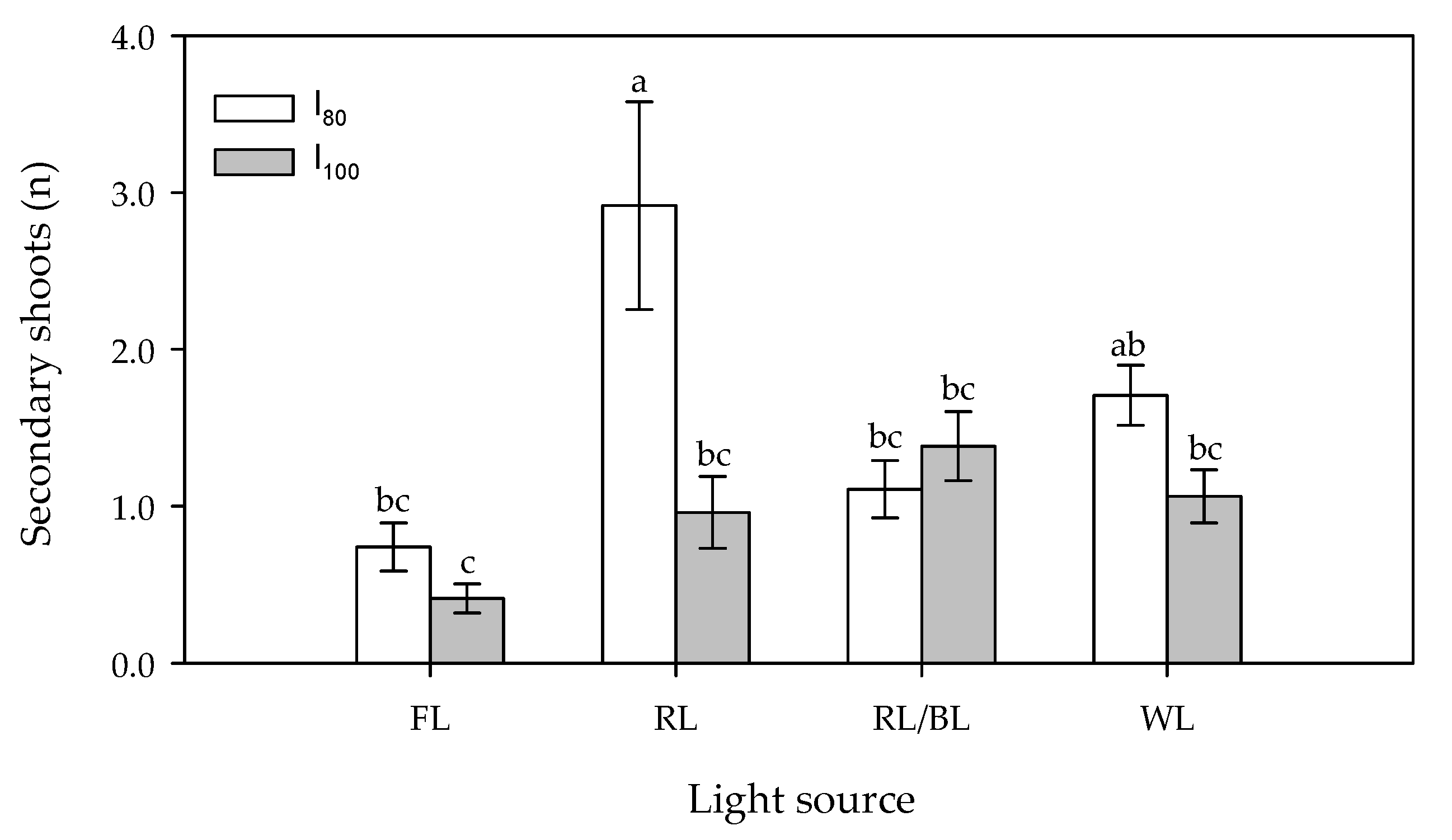
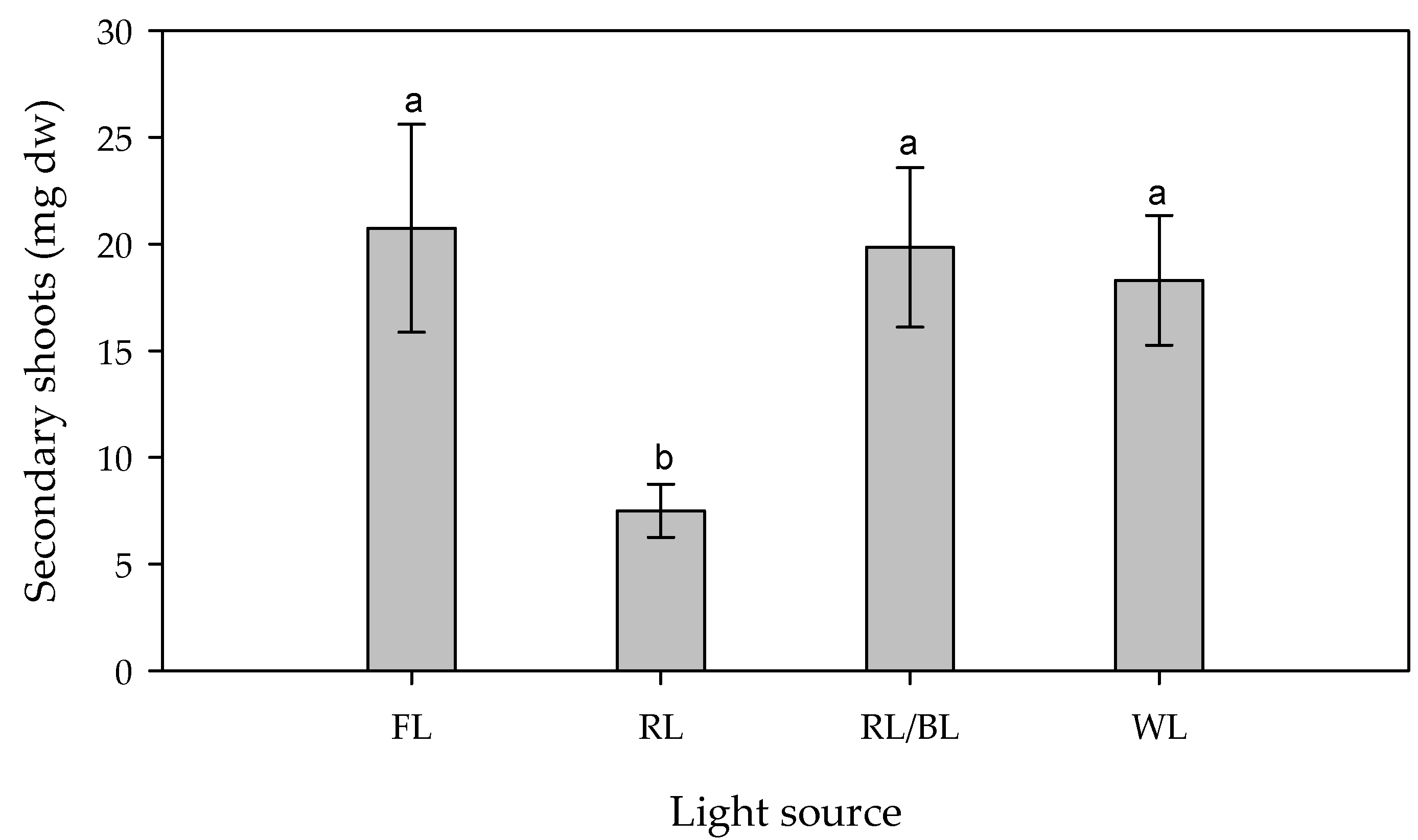
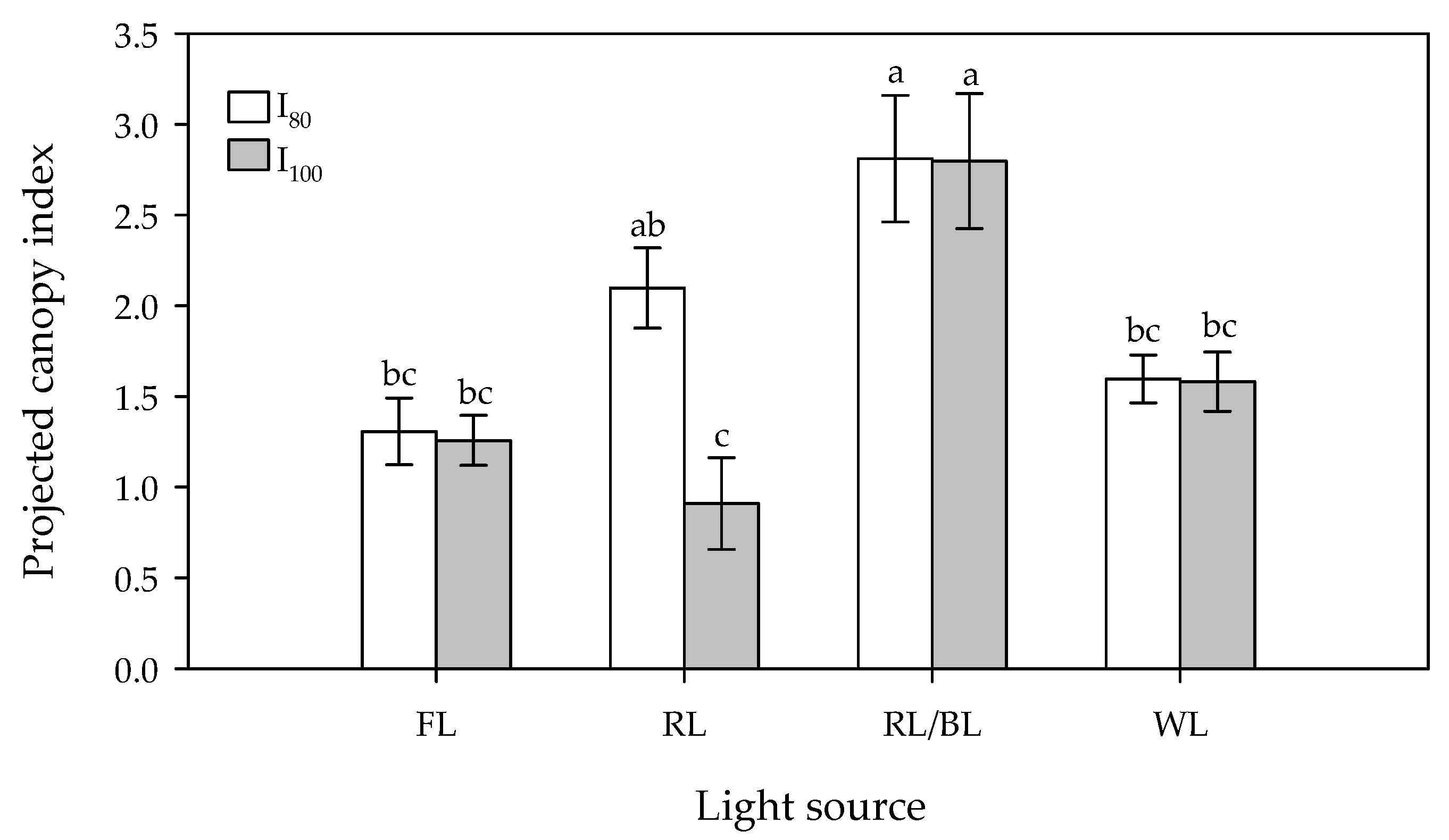
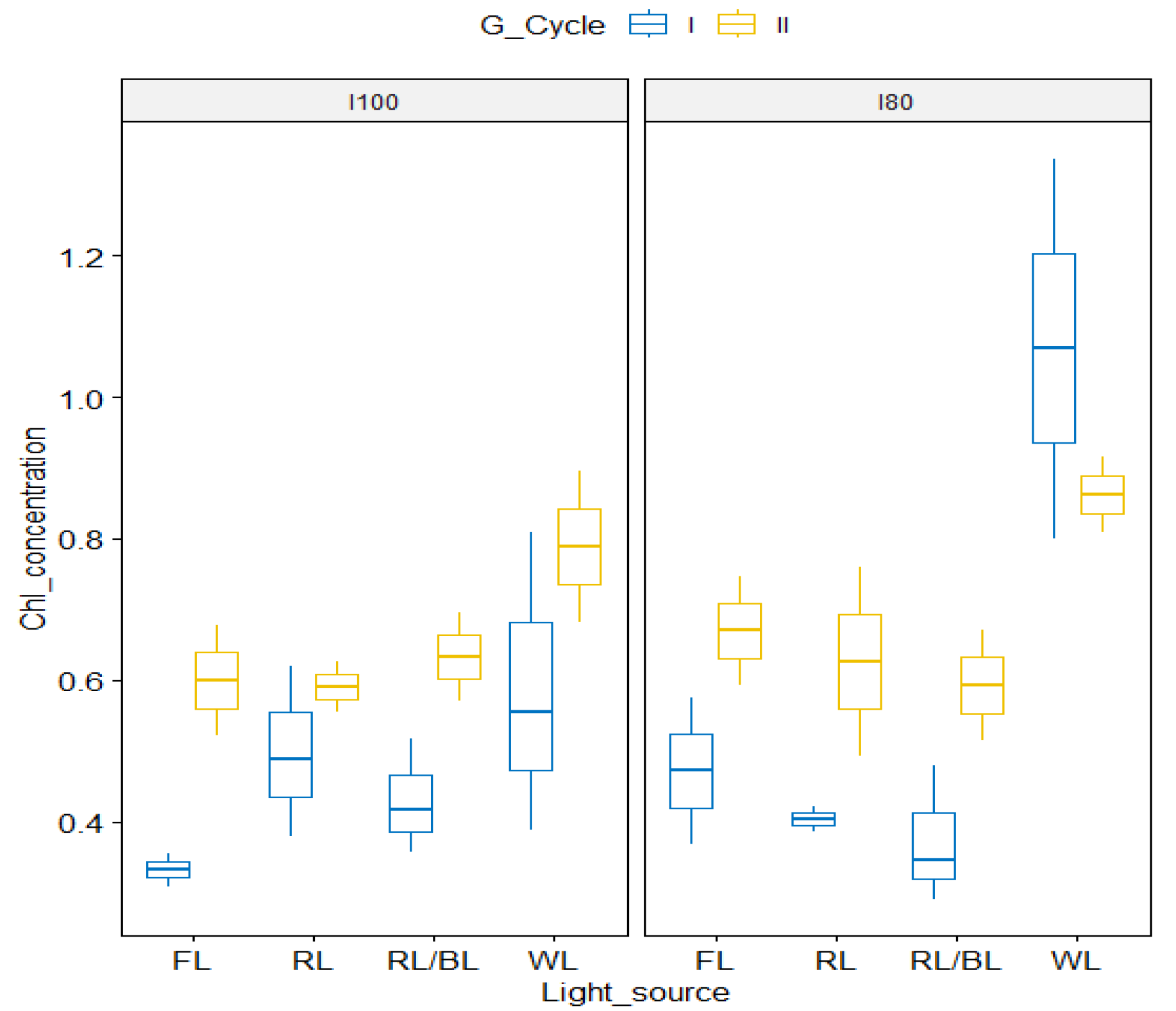
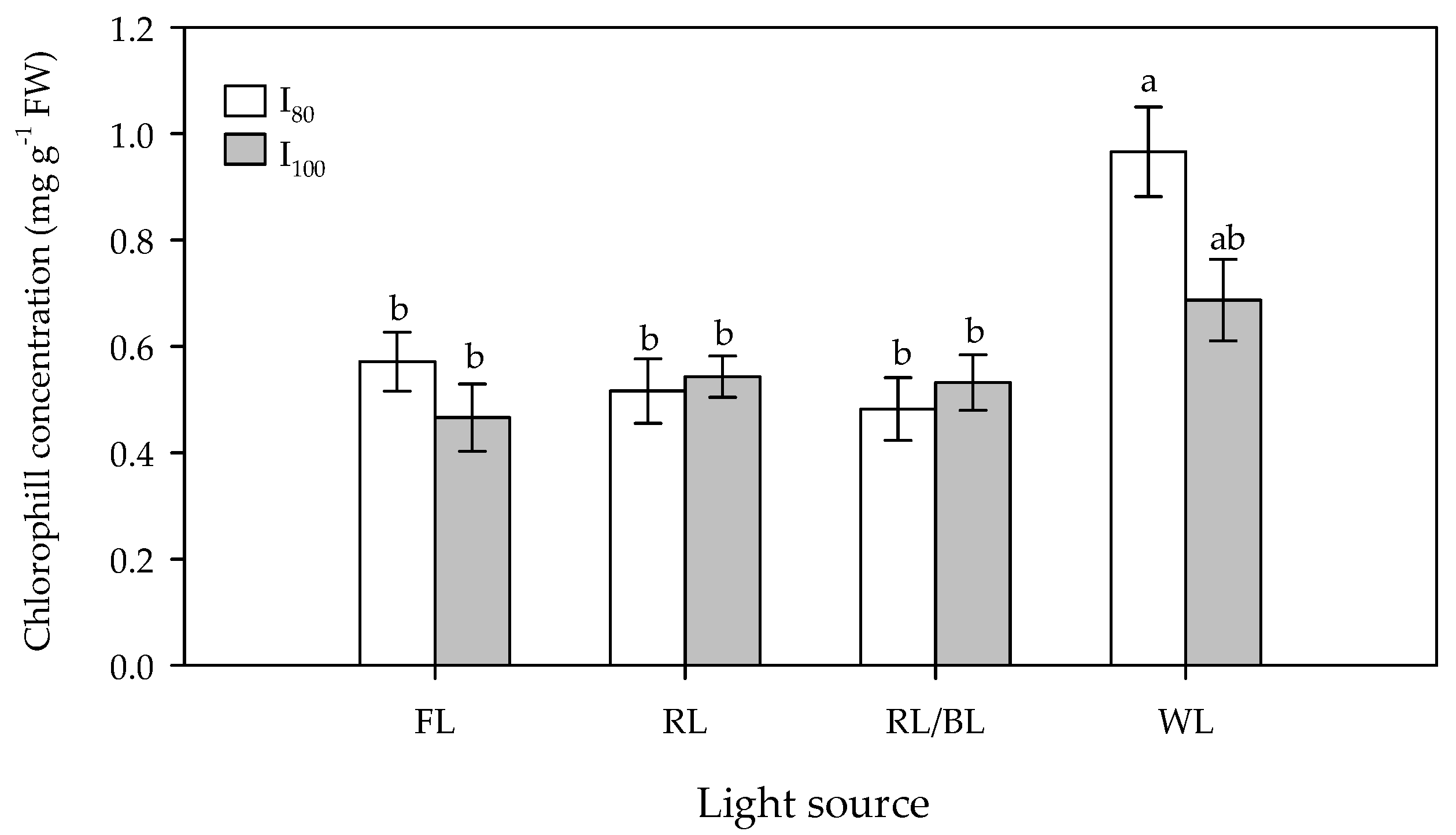
| Source of Variation | Df | NSS (N Plantlet−1) | WSS (mg DW Plantlet−1) | PCI | Chl (mg g−1 FW) |
|---|---|---|---|---|---|
| Fixed factor (F-Statistics) § | |||||
| Light spectra (L) | 3 | 7.32 *** | 5.66 ** | 20.98 *** | 16.60 *** |
| Intensity (I) | 1 | 10.46 ** | 2.84 ns | 1.29 ns | 4.1 * |
| L × I | 3 | 5.40 ** | 2.27 ns | 7.84 *** | 3.97 * |
| Random factor § | |||||
| Propagation Cycle | 0.40 ns | 0.22 ns | 0.18 ns | 0.001 ** | |
| Main Factor (mean values) | |||||
| FL | - | 20.73 a | - | - | |
| RL | - | 7.49 b | - | - | |
| RL/BL | - | 19.84 a | - | - | |
| WL | - | 18.29 a | - | - | |
| Interaction | |||||
| FL. I80 | 0.73 bc | - | 1.31 bc | 0.57 b | |
| FL. I100 | 0.40 c | - | 1.26 bc | 0.46 b | |
| RL. I80 | 2.92 a | - | 2.10 ab | 0.52 b | |
| RL. I100 | 0.93 bc | - | 0.91 c | 0.54 b | |
| RL/BL. I80 | 1.10 bc | - | 2.80 a | 0.48 b | |
| RL/BL. I100 | 1.38 bc | - | 2.81 a | 0.53 b | |
| WL. I80 | 1.70 ab | - | 1.60 bc | 0.97 a | |
| WL. I100 | 1.06 bc | - | 1.58 bc | 0.69 ab | |
Disclaimer/Publisher’s Note: The statements, opinions and data contained in all publications are solely those of the individual author(s) and contributor(s) and not of MDPI and/or the editor(s). MDPI and/or the editor(s) disclaim responsibility for any injury to people or property resulting from any ideas, methods, instructions or products referred to in the content. |
© 2023 by the authors. Licensee MDPI, Basel, Switzerland. This article is an open access article distributed under the terms and conditions of the Creative Commons Attribution (CC BY) license (https://creativecommons.org/licenses/by/4.0/).
Share and Cite
Cavallaro, V.; Avola, G.; Fascella, G.; Pellegrino, A.; Ierna, A. Effects of Spectral Quality and Light Quantity of LEDs on In Vitro Shoot Development and Proliferation of Ananas comosus L. Merr. Agronomy 2023, 13, 1072. https://doi.org/10.3390/agronomy13041072
Cavallaro V, Avola G, Fascella G, Pellegrino A, Ierna A. Effects of Spectral Quality and Light Quantity of LEDs on In Vitro Shoot Development and Proliferation of Ananas comosus L. Merr. Agronomy. 2023; 13(4):1072. https://doi.org/10.3390/agronomy13041072
Chicago/Turabian StyleCavallaro, Valeria, Giovanni Avola, Giancarlo Fascella, Alessandra Pellegrino, and Anita Ierna. 2023. "Effects of Spectral Quality and Light Quantity of LEDs on In Vitro Shoot Development and Proliferation of Ananas comosus L. Merr" Agronomy 13, no. 4: 1072. https://doi.org/10.3390/agronomy13041072
APA StyleCavallaro, V., Avola, G., Fascella, G., Pellegrino, A., & Ierna, A. (2023). Effects of Spectral Quality and Light Quantity of LEDs on In Vitro Shoot Development and Proliferation of Ananas comosus L. Merr. Agronomy, 13(4), 1072. https://doi.org/10.3390/agronomy13041072








